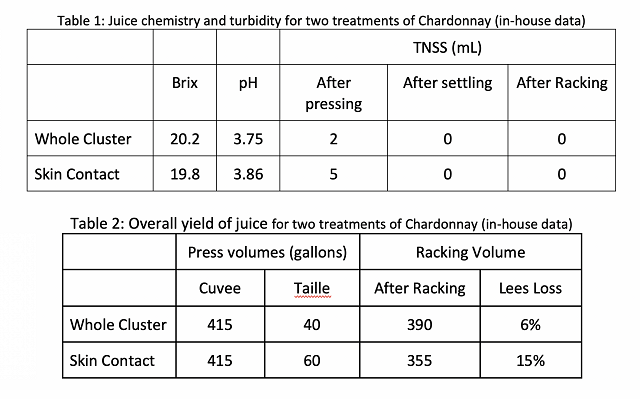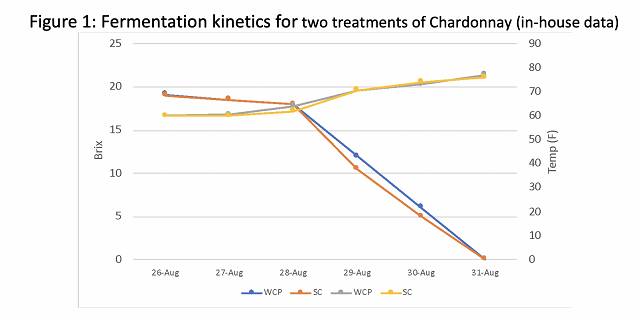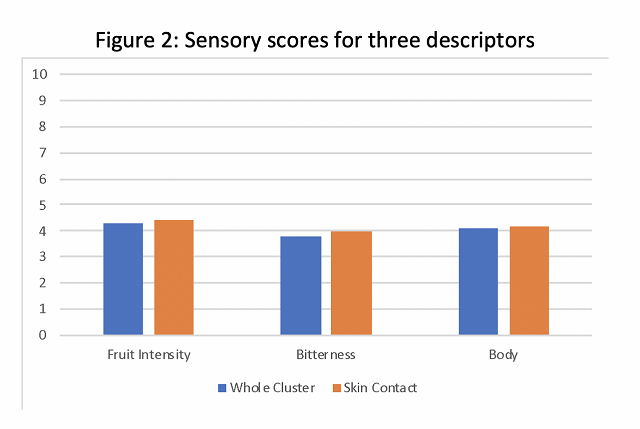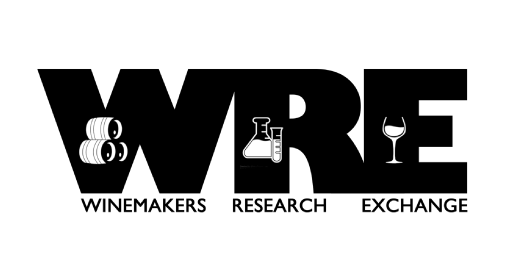Effect of Short Skin Contact on Chardonnay Sensory Characteristics (2018)
Theo Smith
Rappahannock Cellars
Summary
Chardonnay is the most commonly planted grape in Virginia, accounting for an estimated 22% of all Viniferaproduction in the state1. The abundance of available fruit leads to the opportunity to experiment with different styles of production, as many wineries produce more than one Chardonnay product. In this experiment, two press loads of Chardonnay were processed: whole cluster press and 3-4 hours of skin contact. Skin contact produced a larger overall volume of juice and raised the pH both of the juice and resulting wine. Aside from pH, the overall chemistry of the wines was very similar, including most of the phenolic measurements. There were also no significant differences in sensory characteristics of these wines.
Introduction
Chardonnay is the most commonly planted grape in Virginia, accounting for an estimated 22% of all Viniferaproduction in the state1. The abundance of available fruit leads to the opportunity to experiment with different styles of production, as many wineries produce more than one Chardonnay product. There are several winemaking techniques that can be used to produce different styles of Chardonnay, including malolactic fermentation and oak aging. However, these can sometimes also lead to wines that lack acidity or have an undesirable buttery character. This study explores the use of skin contact to produce a richer more full-bodied wine without malolactic fermentation.
There is little difference in phenolic content between red wine skins and white wine skins, with anthocyanins the sole exception. Instead, the difference is in the winemaking, with little skin contact time and limited extraction of phenolics in white wines vs. red wines2.
Skin contact in white wines is thought to enhance varietal aromas and flavors without changing the essential character of the wine. Techniques vary in duration and temperature, but generally include relatively short maceration periods during which crushed grapes are left in contact with juice. Flavor and aroma precursors located in the skin cells of grapes diffuse into the juice prior to pressing, leading to higher levels of volatile aromas3 and more richly flavored wines4. The availability of flavor precursors in skins varies by grape variety and ripeness, with riper grapes more likely to release molecules from skin cells5.
Several studies examined the effect of skin contact in white wines. Alexandre-Tudo et al (2015)6 examined the effect of 12 hours of skin contact at 4°C in South African Chenin Blanc compared to a whole cluster pressed control. Here, some flavor and aroma compounds were lost as well as gained. They measured lower levels of terpenes, esters, acids and thiols and higher levels of alcohols and phenolics in the skin contact wines. This correlated with sensory data showing a shift in perception of fresh and tropical fruits in the control to riper fruit descriptors in the skin contact wines.
Baumes et al (1998) examined the effect of skin maceration for 4 hours at 18°C (a warm maceration) on volatile compounds found in the resulting wine. In each of three varieties (Bourboulenc, Chardonnay, and Chenin), macerated wines had higher volatile compounds such as C6 compounds (217% higher in Chardonnay), Terpenols (122% higher), and lactones (233% higher), leading to richer odor profiles. They point out that these wines did not have any constituents not normally found in each variety, but merely more of them.
As indicated by the above studies, temperature of maceration plays a role in extraction. Ramey et al (1986) tested the effect of 4 different maceration temperatures from 9.7 °C to 28.6 °C. They found warmer temperatures led to higher levels of total phenolics, especially the flavenoid phenols. These are skin and seed phenolics that lead to bitterness and astringency in white wines. These wines also had higher browning capacity and were a rich gold color after barrel aging. Extraction of phenolics followed a linear curve, with the least phenolic fraction extracted at the lowest temperature. Extraction of other volatile compounds was not as limited by temperature. Maceration at 9.7 °C still allowed extraction of C6 compounds and higher alcohols.
In addition to browning potential, skin contact may have other drawbacks. Baumes et al (1998) found higher levels of potassium and other cations, higher polyphenols, and total protein content, higher pH and lower titratable acidity. Ramey et al (1986) describe wines with higher phenolic content having faster browning capacity and higher level of compounds that are perceived as bitter in white wines. Wines with warmer skin maceration also showed higher levels of protein and required more bentonite for stabilization4.
If making a traditional style Chardonnay (as opposed to an orange wine),iIt is highly recommended that skin contact times be kept relatively short (4-18 hours), and proper steps taken to protect juice from oxidation. This includes keeping the juice cold (10 °C), covered in inert gas, and protected by SO2. Skin contact will extract phenolic compounds that are susceptible to oxidation, causing browning. In addition, microbes found on the skins can begin to ferment and cause off odors and difficulty cold settling. Skin contact can also lead to higher extraction of potassium from skins, leading to loss of acid through tartrate precipitation5.
Rappahannock Cellars produces some Chardonnay grown in the Shenandoah Valley that can be thin and lack volume. The purpose of this study was to determine if a short time of skin contact would improve the volume of the wine without leading to bitterness or browning. In this experiment, two press loads of Chardonnay were processed:
- Whole cluster press
- 3-4 hours of skin contact. This fruit was destemmed and pumped into a closed press with CO2blanketing during incubation.
Methods
Fruit was harvested on August 24 and chilled overnight.
For the whole cluster press, fruit was pressed to tank with a yield of 415 gallons (1570 liters) and the addition of 20 mg/L SO2 in the form of KMBS (62 g) and 55 mL/1000 gallon Cinn-Free. The taille was diverted when pH = 3.9 (at 1.0 Bar of pressure).
In the skin contact treatment, fruit was crushed and destemmed into a closed press with CO2 and allowed to macerate for 4 hours. After pressing, 20 mg/L SO2 was added with 55 ml/1000 gallon Cinn-Free. The taille was diverted with pH = 3.8 (at 0.4 Bar of pressure).
Neither taille was included in the trial.
Total non-soluble solids were measured by precipitation in acid after pressing, after settling, and after racking (100 mL of wine was treated with 5 mL phosphoric acid and incubated overnight in the refrigerator). Yield was also determined before and after racking. Juice was clarified then racked to stainless steel tanks before inoculation with 25 g/hL CY3079 and addition of 30 g/hL Superfood. Tartaric acid (2g/L) was added to each tank on the second day of fermentation. Fermentation kinetics (Brix and temperature) were monitored and recorded daily. When wines completed fermentation, an addition of 50 ppm SO2 was made. Two days later, wines were racked off lees to stainless steel storage tanks.
Both treatments have received identical cellar procedures (additions, racking, temperatures, inoculation rate and yeast type) and have been aged in topped stainless steel tanks.
Sensory analysis was completed by a panel of 29 wine producers. Wines were presented blind in randomly numbered glasses. Tasters were presented with three wines, two of one type and one of another, and asked to identify which wine was different (a triangle test). There were three tasting groups with the unique wine in the triangle test balanced between groups. Tasters were then asked to score each wine on a scale of 0 to 10 for fruit intensity, bitterness, and body. They were also given open ended questions to describe the wines. Results for the triangle test were analyzed using a one-tailed Z test. Descriptive scores were analyzed using repeated measures ANOVA.
Results
The whole cluster pressed juice had lower pH than the juice that had seen skin contact (Table 1). There was a higher level of total non-soluble solids before settling in the skin contact juice, however cold settling produced juice of comparable clarity (Table 1). Though both tanks received the same volume of juice initially, the loss from racking was higher in the skin contacted wine than the whole cluster pressed wine (Table 2). Fermentation progressed steadily over 6 days with little difference between treatments (Figure 1).


The chemistry of the resulting wine was very similar. The whole cluster wine has higher acid and lower pH than the skin contact wine (Table 3). Skin contact wine did not have elevated potassium level relative to whole cluster pressed wine. For reference, Berg et al (1979) reported a range of potassium in wine California wine to be 500-1300 mg/L while ETS labs reports a global median of California white wines from 2014-2018 to be 1470-1525 with a range of 800 – 3000 (Rich DeScenzo, personal communication).

Overall, both wines had low levels of phenolic compounds (Table 4). Higher levels of catechin (from grape seeds) were found in skin contact wine, indicating seed exposure. However, higher levels of astilbin (from grape skins) in the whole cluster wine is a surprise, as skin contact allows longer time for extraction. Slightly higher levels of cinnamic acids and grape reactive product in the skin contact wine is expected. These acids are found in the pulp and skins of grapes, and have the potential to contribute to browning. Grape reactive product is a result of oxidation of cinnamic acids. Though protected during cold soak, skin contacted grapes have a longer time for oxidation to occur, and slightly higher level of phenolic substrates for oxidation.
Very low levels of quercetin glycosides and quercetin aglycone, flavenols found in grape skins, indicates skin maceration was not extensive. These compounds can act as aroma precursors, indicating a longer or warmer maceration time may yield higher levels of aromas, however they can also contribute to yellowing. Tannin fractions are similar in both treatments. As tannin content is closely related to juice browning, little difference in tannin indicates this level of maceration is unlikely to lead to additional browning. This is confirmed by very similar absorbance at 420 nm, the wavelength used to measure brown pigments.

In a triangle test comparing whole cluster press and skin contact wines, 9 out of 29 respondents were able to distinguish which wine was different, indicating the wines were not significantly different. There were no significant differences in scores for fruit intensity, bitterness, and body (Figure 2).

Conclusions
Skin contact produced a larger overall volume of juice, but with higher pH. Though press fraction was cut at a similar volume for each treatment, the pH was higher in the treatment with skin contact. After racking, there was lower volume of juice, with higher pH than whole cluster pressing, and a higher level of loss in the form of lees.
Aside from pH, the overall chemistry of the wines was very similar, including most of the phenolic measurements. The skin contacted wine had slightly higher levels of cinnamic acids and grape reactive product, indicating a slightly higher level of oxidation. However, browning was not apparent. There were also no significant differences in sensory characteristics of these wines.
References
(1) Wood, V.; Custer, S.; Watson, K.; Alper, D. Virginia 2018 Commercial Grape Report. 11.
(2) Price, S. F. Phenolic Analysis in White Wines and Juices at ETS Laboratories; Geneva, New York, 2006.
(3) Baumes, R. L.; Bayonove, C. L.; Barillere, J. M.; Samson, A.; Cordonnier, R. E. La Macération Pelliculaire Dans La Vinification En Blanc - Incidence Sur La Composante Volatile Des Vins; 1988.
(4) Ramey, D.; Bertrand, A.; Ough, C. S.; Singleton, V. L.; Sanders, E. Effects of Skin Contact Temperature on Chardonnay Must and Wine Composition. American Journal of Enology and Viticulture 1986, 37 (2), 99–106.
(5) Razungles, A. Extraction Technologies and Wine Quality. In Managing Wine Quality: Volume 2 – oenology and wine quality; Woodhead Publishing: Cambridge, 2010; Vol. 2.
(6) Aleixandre-Tudó, J. L.; Weightman, C.; Panzeri, V.; Nieuwoudt, H. H.; Toit, W. J. du. Effect of Skin Contact Before and During Alcoholic Fermentation on the Chemical and Sensory Profile of South African Chenin Blanc White Wines. South African Journal of Enology and Viticulture 2015, 36 (3), 366–377.
